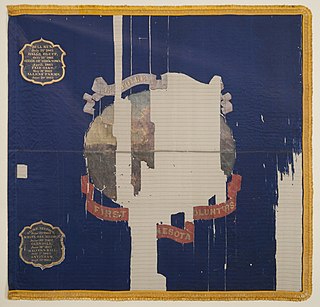
The 1st Minnesota Infantry Regiment was a Union infantry regiment active during the American Civil War. The 1st Minnesota participated in the battles of First Bull Run, Antietam and the Battle of Gettysburg. The regiment's most famous action occurred on the second day of the Battle of Gettysburg when Major General Winfield Scott Hancock ordered the 1st Minnesota to charge into a brigade of 1200 Confederate soldiers. This action blunted the Confederate attack and helped preserve the Union's precarious position on Cemetery Ridge.

Fort Ridgely was a frontier United States Army outpost from 1851 to 1867, built 1853–1854 in Minnesota Territory. The Sioux called it Esa Tonka. It was located overlooking the Minnesota river southwest of Fairfax, Minnesota. Half of the fort's land was part of the south reservation in the Minnesota river valley for the Mdewakanton and Wahpekute tribes. Fort Ridgely had no defensive wall, palisade, or guard towers. The Army referred to the fort as the "New Post on the Upper Minnesota" until it was named for two Maryland Army Officers named Ridgely, who died during the Mexican–American War.

The 1st Minnesota Cavalry Regiment, also known as the Mounted Rangers, was a Minnesota USV mounted infantry regiment that served in the Union Army during the American Civil War.

The 1st Minnesota Heavy Artillery Regiment was a Minnesota USV artillery regiment during the American Civil War.
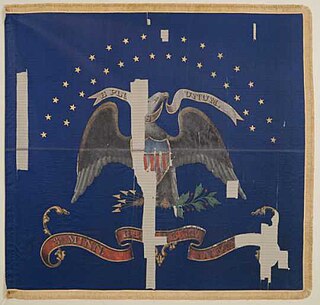
The 3rd Minnesota Infantry Regiment was a Minnesota USV infantry regiment that served in the Union army during the American Civil War. It fought in several campaigns in the Western Theater.

The 4th Minnesota Infantry Regiment was a Minnesota USV infantry regiment that served in the Union Army during the American Civil War. It served in several important campaigns in the Western Theater.
The 6th Minnesota Infantry Regiment was an infantry regiment that fought in the Union army during the American Civil War. The 6th Minnesota Infantry spent much of the war in the Northwest fighting Dakota Indians rather than participating in the battles with the Confederacy. Led by William Crooks, the regiment saw action in the American Civil War mainly with the Dakota Tribe.

The 7th Minnesota Infantry Regiment was an infantry regiment in the Union Army that served in the Western Theater of the American Civil War.

The 8th Minnesota Infantry Regiment was a Minnesota USV infantry regiment that served in the Union Army during the American Indian Wars and the American Civil War.

The 9th Minnesota Infantry Regiment was a Minnesota USV infantry regiment that served in the Union Army in the Western Theater of the American Civil War.
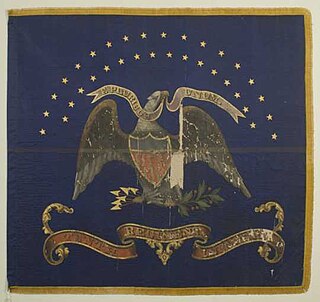
The 10th Minnesota Infantry Regiment was a Minnesota USV infantry regiment that served in the Union Army during the American Civil War.
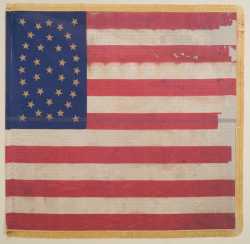
The 11th Minnesota Infantry Regiment was a Minnesota USV infantry regiment that served in the Union Army during the American Civil War. It was the last infantry regiment to be raised by Minnesota during the war.
Brackett's Minnesota Cavalry Battalion was a Minnesota USV cavalry battalion that served in the Union Army during the American Civil War.

Hatch's Minnesota Cavalry Battalion was a Minnesota USV cavalry battalion that served in the Union Army during the American Civil War and American Indian Wars.
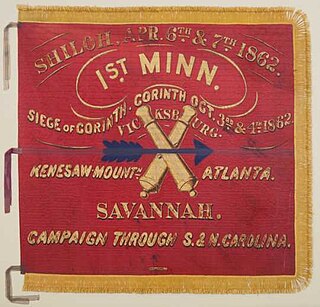
The 1st Minnesota Light Artillery Battery was a Minnesota USV artillery battery that served in the Union Army during the American Civil War. The battery was mustered in at Fort Snelling, Minnesota. on November 21, 1861.

2nd Minnesota Light Artillery Battery was a Minnesota USV artillery battery that served in the Union Army during the American Civil War.

The 3rd Minnesota Light Artillery Battery was a Minnesota USV artillery battery that served in the Union Army during the American Civil War and the American Indian Wars.
The 6th Indiana Infantry Regiment was an infantry regiment from the State of Indiana that served in the Union Army during the American Civil War. This regiment was the senior Indiana regiment of the Civil War, as it was numbered first in sequence after the five Indiana volunteer regiments which had served in the Mexican–American War. The regiment was originally mustered-in for a three-month period of service between April and August 1861, but after its initial term of service had expired it was re-formed in September 1861 for a further three-year period, before being mustered out in September 1864.
The 5th Iowa Cavalry Regiment was a cavalry unit from Iowa that served in the Union Army during the American Civil War.
The 11th Kansas Volunteer Cavalry Regiment was a cavalry regiment that served in the Union Army during the American Civil War.












